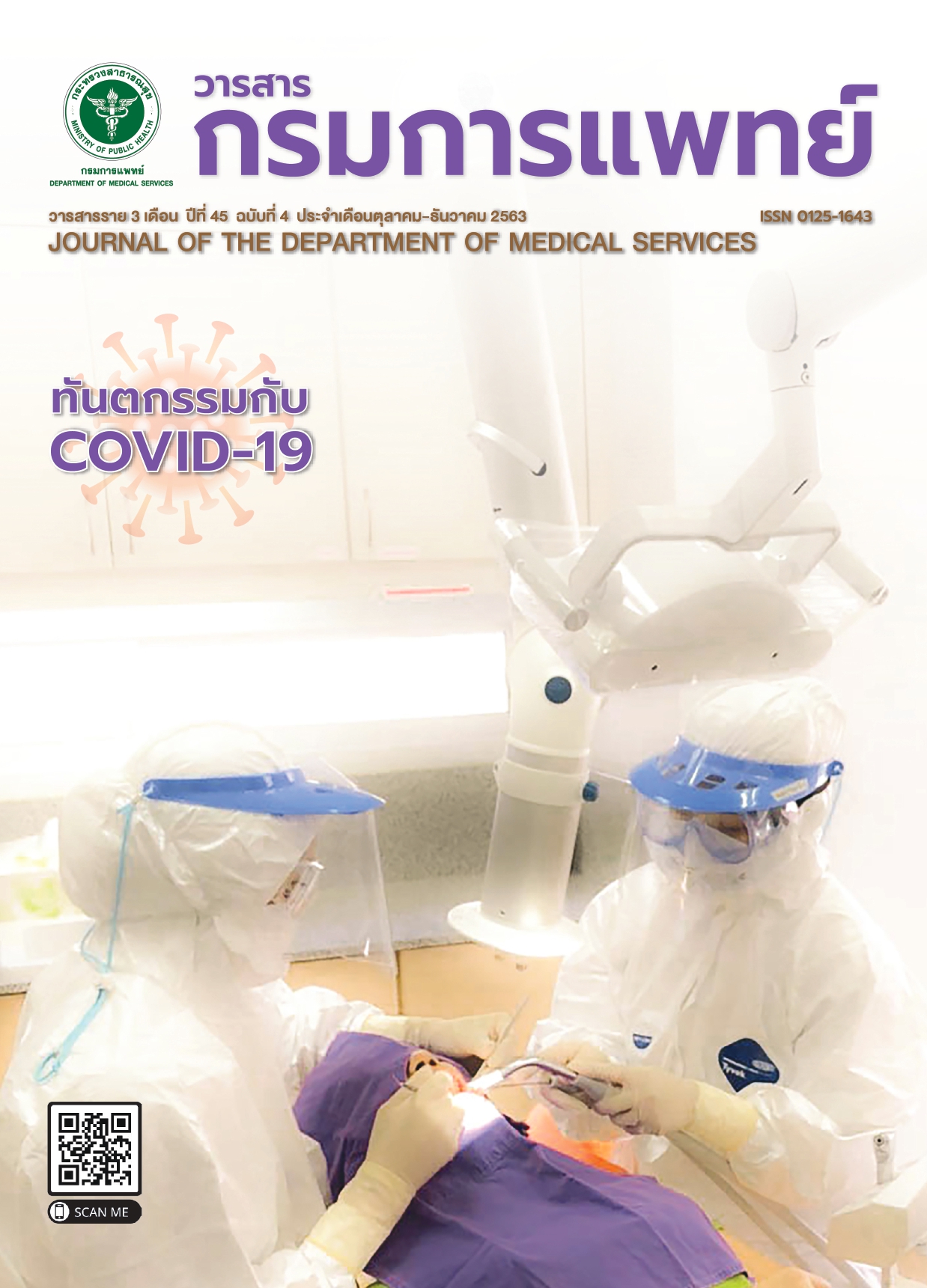A Comparison of Intranasal 0.05% Oxymetazoline and Intranasal 3% Ephedrine for Reducing Nasal Congestion: A Double-Blind Randomized Controlled Trial
Keywords:
Nasal obstruction, Peak nasal inspiratory flow, Oxymetazoline, EphedrineAbstract
Background : There are many drugs that used to reduce nasal congestion, both oral and nasal spray. Nasal sprays divided into 2 groups: the beta phenylethylamime derivatives and midazoline derivatives and there are no comparative study of the effectiveness of these two drugs to reduce nasal congestion.
Objective : to evaluating the efficacy of using intranasal 0.05% oxymetazoline, and intranasal 3% ephedrine to reduce nasal congestion.
Method : A double-blinded randomized controlled trial was conducted in 84 patients ages ranging from 18 to 60 years with nasal congestion at the Department of Otolaryngology, Burapha University Hospital from January to April 2020. The level of nasal relief was measured by Peak Nasal Inspiratory Flow (PNIF) before and after using the intranasal spray 10 minute,Visual Analogue Scale was measured before and after using the intranasal spray 10, 30 minute. Then descriptive statistics and independent Paired t-Test were applied to analyze the data.
Results : The 84 patients (49 female, 35 male) with an average age of 39.54 years revealed that the level of PNIF measured before and after spraying 0.05% oxymetazoline and 3% ephedrine were statistically significant difference. (p-value < 0.005, 95% CI = -49.74, -26.45 and p-value < 0.005, 95% CI = -50.72, -31.42, respectively). The visual analog scale recorded before and after spraying 0.05% oxymetazoline and 3% ephedrine also showed a statistically significant difference (p-value < 0.005, 95% CI = 1.523, 2.287 and p-value < 0.005, 95% CI = 2.656, 3.535 respectively). The measuring PNIF at 10 minutes after using the intranasal spray illustrated that both drugs could increase the level of nasal relief. However, a non-significant difference was reported when comparing these two drugs (p-value = 0.847, 95% CI = -19.9, 24.2).
Conclusion : the two drugs cloud reduce the blockage of the nasal passage, physicians may consider using them after deliberating other factors.
References
Asanasen A.nasal obstruction. [Internet].2009[cited 2019 Aug 18].Available from:http://www.rcot.org/pdf/nasal_doc.pdf
Cartabuke RS, Anderson BJ, Elmaraghy C, Rice J, Tumin D,Tobias JD. Hemodynamic and pharmacokinetic analysis of oxymetazoline use during nasal surgery in children.Laryngoscope 2019; 129: 2775-81.
Druce HM, Ramsey DL, Karnati S, Carr AN. Topical nasal decongestant oxymetazoline (0.05%) provides relief of nasal symptoms for 12 hours. Rhinology 2018; 56: 343-50.
Bellew SD, Johnson KL, Nichols MD, Kummer T. Effect of intranasal vasoconstrictors on blood pressure: a randomized,double-blind, placebo-controlled trial. J Emerg Med 2018;55: 455-64.
Trakarnsilpa C, Arpornchayanon W, Hanprasertpong N,Fooanant S, Manorot M, Roongapinun S. Two-hour nasal responses after a single dose of ephedrine nasal spray in healthy males. J Med Assoc Thai 2017; 100: 358-64.
Pritchard S, Glover M, Guthrie G, Brum J, Ramsey D, Kappler G, et al. Effectiveness of 0.05% oxymetazoline (Vicks Sinex Micromist®) nasal spray in the treatment of objective nasal congestion demonstrated to 12 h post-administration by magnetic resonance imaging. Pulm Pharmacol Ther 2014;27: 121-6.
Vaidynathan S, Wiliamson P, Lipworth B. Comparative evaluation of nasal blood flow and airflow in the decongestant response to oxymetazoline. Ann Allergy Asthma Immunol 2012; 108:77–80.
Eskiizmir G, Hirçin Z, Ozyurt B, Unlü H. A comparative analysis of the decongestive effect of oxymetazoline and xylometazoline in healthy subjects. Eur J Clin Pharmacol 2010; 67:19–23.
Meekul N, Tantilipikorn P, Bunnag C. Peak Nasal Inspiratory Flow; normal value in Thai adults[Internet].2009 [cited 2019 Aug 18].Available from: http://www.rcot.org/download/Peak_Nasal_Inspiratory_Flow2009.pdf
Blackford L, Shaklb S, Taverner D. The nasal airways response in normal subjects to oxymetazoline spray:randomized double-blind placebo-controlled trial. J Clin Phamacal 1999;48: 53-56.
Browning MG, Seddon JO, Yung LT M, Gough G. An unusual case of systemic cardiovascular side effects from the application of over-the-counter nasal decongestion drops. BMJ Case Rep 2011:1-2.
Montastruc F, Montastruc G, Taudou MJ, Olivier-Abbal P,Montastruc JL, Bondon-Guitton E. Acute coronary syndrome after nasal spray of oxymetazoline. Chest 2014; 146:214-15.
Laccourreye O, Werner A, Giroud V, Couloigner P, Bonfils P,Bondon-Guitton E. Benefits, limits and danger of ephedrine and pseudoephedrine as nasal decongestants. Eur Ann Otorhinolaryngology Head Neck Dis 2015;132:31–4.242 |
Downloads
Published
How to Cite
Issue
Section
License
บทความที่ได้รับการตีพิมพ์เป็นลิขสิทธิ์ของกรมการแพทย์ กระทรวงสาธารณสุข
ข้อความและข้อคิดเห็นต่างๆ เป็นของผู้เขียนบทความ ไม่ใช่ความเห็นของกองบรรณาธิการหรือของวารสารกรมการแพทย์



